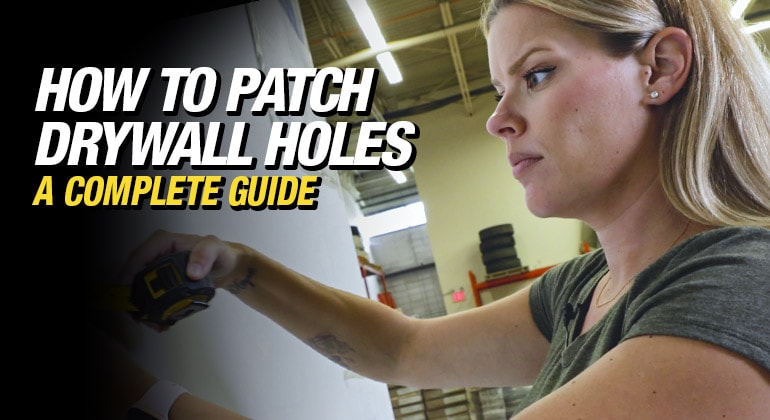Heat Pump vs Conventional AC (Air Conditioner): Which is Better for Cooling? Summer is here and it’s bringing the heat. But I can’t complain because I love the summer weather,...

How To Patch Drywall Holes (7 Easy Steps)
By Sherry Holmes
Mike’s Advice / Design & Renovation Inspiration
Wednesday, December 8th, 2021 @ 2:18pm
A Complete Guide – How to Fix Holes in Drywall
We’ve all been there; whole, dent, scratches, or imperfections in our walls and/or ceilings at home. We tend to ignore them, cover them up, or just let them get worse.
A drywall repair can be a daunting and messy task, often neglected. I know I have had my share of repairs around the house I have always left for a “rainy day” project, and then completely forgotten about. I know I don’t want to tackle more work after work; especially when it can be messy.
The Traditional Way To Patch Holes In Drywall
When I was younger, even before I started my career in the skilled trades as a contractor, my dad taught me a little drywall patch trick. In fact, he’d teach everyone this quick little trick of his – he’s even done it as a demo on different morning shows to demonstrate. So naturally, it was something that he HAD to explain in-depth to both my brother and me.
Small Trick to Fix Drywall Holes in the Past
He’d start off by measuring out the patch he needed to make – but leaving extra space on all four sides. Knowing the actual measurements of the patch, he’d then trace it out, and score the back of the drywall to peel the backing, without harming the paper.
A New Way to Fix Holes in Drywall
The paper left intact would then act as taping to help secure it to the wall. Easy, right? Obviously, this little trick is better suited for smaller patches and is still both messy and time-consuming.
However, I’ve found a better way to repair drywall holes. And I wanted to share it with everyone, including my father; to let you all know how amazing this patch is!
Can I Repair Drywall Myself?
The short answer is absolutely! FibaTape self adhesive drywall patches are the BEST and easiest way to patch your drywall with less mess and less work. They come in six different sizes and easy to follow instructions. This really is for anyone – the DIYer, homeowner, or contractor.
Really great home improvement project for the weekend!
#1 Gather the Tools Needed to Patch Drywall
Before you get started, here is a list of some of the tools you will need:
- Fiba Tape wall repair patch (available at Lowe’s)
- Utility Knife
- Putty/drywall compound
- Sanding sponge
- Measuring tape
- Putty knife/trowel
- Safety glasses
#2 Clean Up
The very first thing you need to do is clean up and remove any debris around the hole in the wall and clean up the area. There might be loose drywall and dirt that you will want to get rid of, especially around the edges of the hole.
#3 Small Holes or Large Holes? Determine The Size
Measure the size of the hole you are trying to fix – this will determine what size repair patch you will need. Always make sure to get a patch that is a little bigger than the hole you’re fixing, so you have the extra room for your patch to grip.

Here’s a tip-You can also trim the patch to the size you need.
#4 Choose Your Wall Repair Patch
The Fiba Tape patches that I recommend and use are made of patented, reinforced fiberglass mesh that protects the repair from repeat damage or cracking. They have an aluminum backing to provide that nice strong bond we’re looking for, AND it won’t rust.

#5 Apply the Patch
These patches are self-adhesive with cross-directional fiberglass mesh, so all you have to do is peel the back liner (from the edges of the patch), apply it to the wall, and press it firmly into place. You will see that it creates a smooth surface to apply your drywall compound.
#6 Apply the Compound
Once you’re ready to apply your drywall joint compound, you will see that the compound will embed itself into the patch to provide the strength you’re looking for. Follow the manufacturer’s guide on the drying time when it comes to your compound.
What kind of putty is used for drywall?
If you are repairing small damage to your drywall, you can use spackle. It comes pre-mixed in smaller containers. It dries quickly which means you can sand it and paint it quickly.
A joint compound on the other hand (also called mud by pros) is typically used when you hang new drywall. It doesn’t dry as quickly as spackle so you have more time to work at it. If you do have a tub of joint compound leftover from a previous project, you can substitute it for spackle in a small repair job.
#7 Sand It & Paint It
Let the patched areas dry, and sand them lightly. Go in with as many coats as needed to cover your patch appropriately. Lightly sand when finished, and paint. Simple!
THAT IS IT! You’re done and have a perfectly repaired drywall patch. Fixing drywall shouldn’t be an intimidating task. The FibaTape Wall Repair Patches take all of the guesswork, prep, and mess out of repairing your drywall patches at home. I love it, and I’m certain you will too!
The best part – I got to teach my dad a new, better trick.
Happy patching!
Frequently Asked Questions:
How do I patch a small hole in drywall?
A small hole in your wall can be patched using a drywall repair patch. This is an easy DIY project.
What is the cheapest way to fix a hole in drywall?
Depending on the size of the hole, you can use a repair patch. The ones I use (Fiba Tape) come in different sizes. Very affordable, and you may already have the rest of the materials you need, such as putty and a sanding sponge.
How do you fix a 12×12 hole in drywall?
For repair jobs on bigger holes, cut a piece of drywall into a square shape that’s 2 inches larger in width and height than the area you are repairing. You will want to trace that piece of drywall on the wall and then cut along the lines on the wall with a drywall saw.
Secure the new piece with wood backing strips and drywall screws. Then apply joint compound over the seams.
READ NEXT
5 Repair Projects You Can Do On Your Own
Painting Tips For Your Rooms











